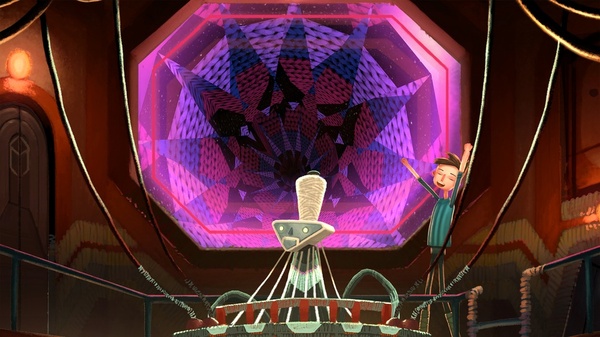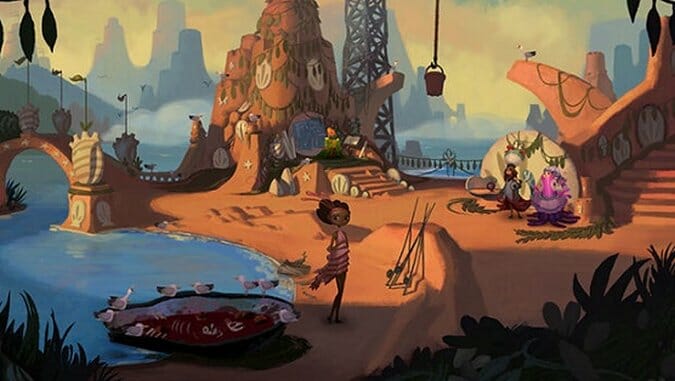There’s a scene in Broken Age: Act 2 involving a character who has based its entire existence around having created a problem for itself. The problem—as the character sees it, anyway—has an extremely specific solution, and when that solution becomes unavailable the character and its friends wind up inconsolable. While the game’s protagonist does her best to propose various stopgaps, up to and including reminding the characters that they’re in a prison of their own design, nothing will do. “Please think about these solutions before you present them!” the character exhorts, in between sobs of despair. Eventually, the flimsiest possible facsimile of the character’s solution slips by it and its friends undetected. All involved parties have a great time as a result.
In a way, then, the crying character had the right idea; manufacturing problems with ridiculous, arcane solutions can be a win-win. As long as you don’t mind being despondent or embarrassed while your concerns are not properly addressed, you get to blame the universe if things don’t work out. If things go your way, however, you’re allowed the tangy euphoria of getting exactly what you want, on your terms.
Which brings me to adventure games.
Point-and-click adventures like Broken Age know exactly what they want. They present impossibly convoluted situations and give the player the opportunity and raw materials to sort things out. (One of the most diabolical puzzles in Act Two consists of untying a really complicated knot.) The player is given the satisfaction of basically reading the game’s mind, and of having solved a very specific, tangible problem. The game (and by extension, I guess, the game’s designer) is afforded that aforementioned tangy euphoria.
I’ve never quite understood gripes about the hilariously implausible solutions adventure games dictate for their puzzles. There’s no objective level of insanity that the puzzles occasionally cross; the extent to which a puzzle is bad is just a function of how much it takes the player out of being absorbed in the rest of the game. Suspension of disbelief—being willing to submit oneself whole hog to adventure games’ hairbrained versions of reality—is what makes them so fun. Would walking Gabriel Knight to a costume shop to buy a fake mustache have made for a better game? Guybrush Threepwood, with his self-awareness and tendency towards nonviolence, would have made a terrible pirate. Ben and his Polecats opted for Full Throttle’s electric bunnies and fake IDs instead of methamphetamine and unlicensed firearms, thank God.
By the same token, the worlds and narratives in these games are weird, detailed and internally cohesive enough that their “reality” transcends both the perennial shoddiness of their protagonists’ fake mustaches and their utter unwillingness to talk to anyone about their increasingly absurd problems. The way the worlds of games like this can ring true trumps the fact that, as systems, they come off like total whiny babies. On some level, almost every single one of my friends reminds me of at least one of Day of the Tentacle’s three main characters.

Considering it’s literally split across two games, it’s a given that Broken Age lacks a certain amount of this internal cohesion. Taken as one work, though, Broken Age still feels conflicted about its two-act structure, and the fact that its division was primarily a business decision tends to show despite Double Fine’s best efforts.
On one hand, there are little narrative moves in both acts that successfully segment them into somewhat discrete works. Act One, for example, stuck its landing perfectly, with a cliffhanger ending that confirmed some suspicions and teased brand new ones until Act Two could be released. Act Two picks up inelegantly, however (a major inciting incident happens completely offscreen and for reasons that are never quite nailed down), and after Act One’s cavalcade of interesting places and characters, waiting over a year to mostly retread those same experiences feels like more of a letdown than it would have been if the experience had been seamless from the jump.
Act One of Broken Age seemed to be shooting the moon with its narrative setup—man-eating monsters, spaceships, comings of age, mysterious coyotes and menacing knives were all left on the table for over the last year. While Act Two’s humor, voice acting and art direction remained superb, its narrative—one of the caliber set up in Act One, anyway—acts as the connective tissue that makes those other things worth caring about. When such deliberate care was taken with other parts of the game, it’s hard not to feel shortchanged when its story calls for the player to listen to a plodding exposition dump from a JRPG-style out-of-nowhere “fight the real enemy” antagonist, or when it sweeps promising narrative threads under the rug like a television show that got canceled midseason.
Alongside its shift away from world building, Act Two sees Double Fine placing the emphasis on puzzle design. So much so, in fact, that it comes off like Double Fine rear-loaded all the parts where players would get stuck. I spent a couple of hours kicking the tires on a few of Act Two’s puzzles, and am still going back and forth between remembering how irritating it was to be stuck and remembering the relief I felt when I finally figured out an answer. The difference here felt particularly jarring; there was nothing in Broken Age’s first act that exasperated me in the way that two or three puzzles in Act Two lured me into the classic “try everything on everything else” adventure game state.
Broken Age’s story and difficulty may form a more graceful arc if played all at once, but Act Two’s scales tip so abruptly away from narrative and towards puzzle-solving that it seems empty and tedious in comparison to its predecessor. Areas are crisscrossed until every detail has been squeezed from them. Lines of dialogue end up repeated ad nauseam. The neat little structure of the game’s fiction collapses under the weight of (to use one example from Act Two) “being pretty sure I gotta do something with this giant snake, but not knowing what it is.”
Coming off how frustrated Act Two made me, and how little denouement I felt at its (non-)conclusion, I can’t help but be a little let down by it. But isn’t this what I was hoping for? Isn’t it a point-and-click adventure game designed by “Grim” Tim “Fandango” Schafer? To what extent are atmospherically untenable puzzles and a storyline that’s never quite as good as one remembers fixtures of the genre Schafer pioneered and, by extension, the game basically everyone on the internet told him they wanted when they gave him three million dollars? Broken Age’s second act is kind of a slog, but it’s possible I should take a lesson from its crying character: When I hope for something extremely strange and specific, I shouldn’t complain if I actually get it.
Broken Age: Act Two was developed and published by Double Fine Productions. We played it on the PC, and it’s also available for the Mac, Playstation 4, PS Vita, iOS and Linux.
Joe Bernardi is on Twitter.

